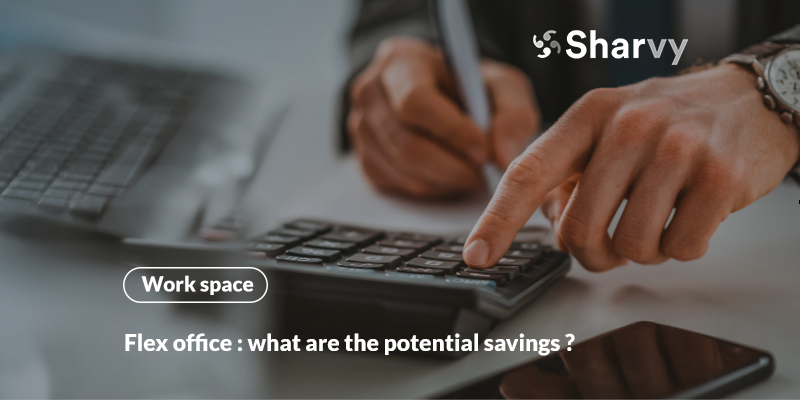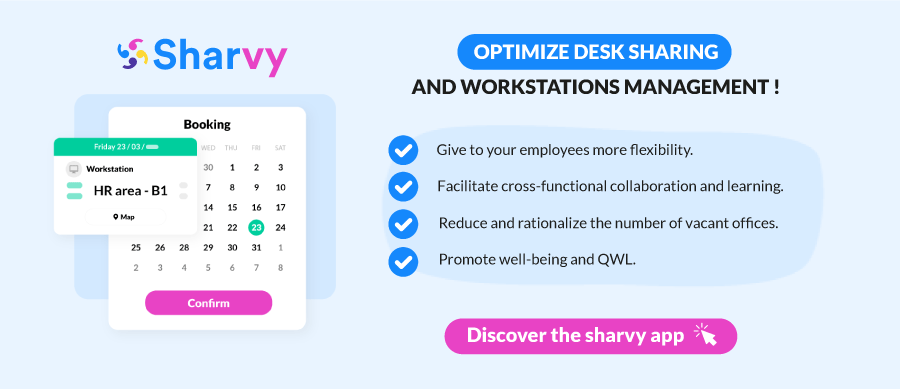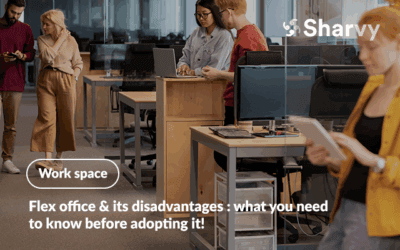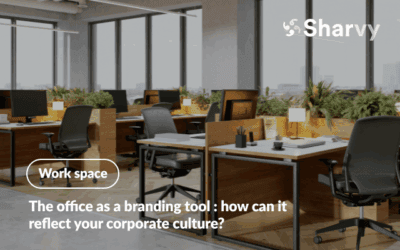The spleen of ghost offices? Here’s a curious metaphor that has descended on British life since the start of the Covid-19 pandemic, with its corollary : teleworking.
The origin of this metaphor is as follows : since the end of the pandemic, the United Kingdom has been going through a period of high inflation, affecting companies and forcing them to reassess their priorities.
As a result, managers can no longer bury their heads in the sand in the face of the irresistible rise of the flex office. Flex office is emerging as a new era, relegating the concept of traditional workspace allocation to the status of antiquity. While many managers are keen to take advantage of professional nomadism and the flex office to make significant savings, they should be open to this practice.
In this article, please find out more about the costs of the flex office, the (often unsuspected) savings to be made by implementing this practice, and our advice on how to make a smooth transition and avoid substantial costs.
A quick reminder : what is the flex office?
The essence of the flex office is that employees are no longer allocated a specific workstation. Once on-site, they choose their anchor point for the day and begin their tasks. In this sense, it is a practice that allows employees to regain control over their working environment.
Each day has its desires, objectives, and affinities. The idea is that each space can be used for a specific purpose. That’s what flexibility at work is all about : the rigidity of fixed desks, the same place every day with the same colleagues in sight, is a thing of the past.
As a result, it’s an innovative solution for creating unstructured teams and impromptu meetings. It’s a virtuous circle, creating a dynamic working environment. The synergies created foster agility, productivity, and creativity.
However, the flex office cannot be improvised because it impacts the work organization. It has to be learned, practiced, and implemented step by step.
That’s why we’ve created a comprehensive guide with many actionable tips relaying the benefits, prerequisites, best practices, and diverse feedback to help you successfully transition to the flex office! Download it for free here.
The costs of flex office…
While flex office is increasingly attractive to employers looking to cut costs and optimize their workspaces, it should be remembered that it requires a considerable initial investment. Two types of costs are involved in deploying a flex office : the costs of switching to a flex office and the day-to-day costs of managing it.
1. The reorganization of workspaces.
Moreover, flex office gives your offices a new look, making them more collaborative, creative, and user-friendly! Whether company relocation or reorganizing your workspace, you must ()fit out your premises accordingly.
Employers organize their workspaces in a flex office environment according to “Activity Based Workspace“. The idea behind this concept is that each company area should respond to a given activity. There’s no need for major works; it’s more a question of optimizing and fitting varied, evolving, and modular spaces.
With this objective in mind, we can imagine creating various workspaces, with :
- The essentials : individual workstations and open spaces.
- Spaces offering audio privacy : PhoneBooth, meeting room, huddle room.
- Collaborative spaces : corpoworking, informal spaces, relaxation areas, etc.
However, this reorganization of workspaces is (usually) accompanied by various expenses.
These include spending on the services of an architectural firm to rethink new premises and the layout of new spaces. Some firms, such as Parella, can help employers make the right decisions by providing tailor-made real estate solutions.
At the same time, there may be costs associated with any labor required to carry out work on the premises: moving partitions, covering floors, installing new light sources, new paintwork, solutions to ensure thermal comfort for employees, and so on. While these costs can be anticipated, they should be noticed when switching to a flex office.
For example, consulting an interior architect to rethink the layout can cost between €2,500 and €5,000, depending on the complexity and size of the premises. Moreover, fitting out common spaces, including the addition of flexible furniture such as modular seating or meeting tables, can represent an additional budget of €5,000 to €10,000.
2. The purchase of computers and technological equipment.
Because it is based on digital technology, the flex office also requires changes to IT equipment. Let’s remember: different profiles emerge in a flex office environment, from sedentary employees to ultra-nomads who regularly change workspace during the day.
In correlation, this organization of work creates different needs :
- A need to universalize company workstations. Since employees no longer have a fixed desk, they need to be able to work at any workstation they want. Ultimately, the task for companies is to “universalize” their workstations to facilitate flex offices. Installing computers with similar performance and identical screen sizes in open spaces makes sense.
- A need to provide each employee with laptops. These must be chosen according to the job and the user’s tasks. For example, a salesperson might prefer a lightweight laptop, whereas a computer graphics designer might select a high-performance model.
- A need to equip and modernize meeting rooms. In particular, I will provide them with audiovisual equipment for videoconferencing. For example, by installing interactive screens, video projectors, speakers and microphones, “Plug & Play” technology, etc.
However, there is a lot more IT equipment to add to this “shopping list”. These include docking stations (compatible with all laptops), wireless keyboards and mice, multifunction printers for every open-plan office, etc.
Finally, remember that equipment mobility (due to flex office) can increase the risk of damage, loss, or theft. Make sure you anticipate this by having a replacement fleet, for example.
3. The purchase of furniture.
Purchases will also have to be made to furnish the new workspaces and meet the needs of each employee. Your employees are all physically different. As a result, the furniture available (particularly in a flex office) must be adaptable to each individual. For example :
- The seat height must be adjustable.
- The backrest must be able to recline with body movements.
- The armrests should be flexible to take the strain off the shoulders and neck.
- The headrest should also be adjustable to relieve neck strain.
- Seats with castors are preferable to adapt to any floor.
At the same time, it’s worth remembering that a sedentary lifestyle is a scourge of office life. To increase movement in your workspaces by installing standing desks and high tables. You can also offer ball seating, known for its ergonomic benefits.
Likewise, it would help if you considered installing various storage units and lockers so employees can store their personal belongings, hence the importance of applying a “Clean desk policy“. At the same time, various decorative elements will be needed, such as plants and shrubs, coat hooks, accent lamps, etc.
Whatever the case, remember that your workspaces need to adapt to professional nomadism while trying to recreate the comforts of home : this is what we call “Home at the office“.
4. The flex office management.
Particular attention needs to be paid to the day-to-day management of the flex office. When opting for this work organization, taking office-sharing literally by pooling workstations is essential.
So, if your company has around fifteen employees, you only need to offer about ten individual workstations. To do this, it’s all a question of organization and managing the workstations internally on a rota basis.
But this (inevitably) requires investment in a desk booking solution.
Remember that during a transition, your employees will often be reluctant to change their routine and tend to want to come more than usual, leading to over-occupation.
In the long term, a lack of organization can lead to peaks in occupancy and, as a result, too many employees on-site on the same day. To avoid this, a desk booking solution like Sharvy guarantees employees a workstation when they arrive on site. This way, you move away from the traditional flex office approach based on the “first come, first served” principle. Your employees can reserve a place before arrival and relieve themselves of this daily stress.
Setting up this type of tool involves costs : subscription, deployment to administrators, technical specifications, installation of access control equipment, specific developments, etc. But keep sight of the benefits.
Possible savings thanks to the flex office!
1. A reduction in property expenses.
In 2023, a workstation costs an average of $13,500 per employee per year. So, considering a company with 50 employees, the expenditure linked to property charges comes to more than $675,000 a year.
Today, offices represent the 2nd largest item of expenditure for companies after the wage bill. As a result, most companies are taking action by opting for the flex office in the face of spiraling property prices.
And the reason? It’s obvious : since the end of the Covid-19 pandemic and the resurgence of teleworking, employees are rarely together (all at the same time) at their place of work. As a result, floor space has become too large, and many offices still need to be occupied. Managers are bitterly disappointed by the low occupancy rate of their offices.
By not keeping one workstation per employee and reducing the floor space required, thanks to the flex office, managers can improve the profitability of their premises. This makes it possible for them to reduce the number of workstations and move to and rent smaller but higher quality premises, enhanced by services that improve the Quality of Life at Work (QWL).
So, if we take the example of a company with 50 employees, it would go from 50 workstations to 40 workstations. With 50 workstations, the annual expenditure would be $675,000. However, by downsizing to 40 workstations thanks to the flex office, the company can save almost $135,000, or 25% over a year, which is not insignificant!
Added to this are gains in employee well-being, increased productivity, and so on. Return on investment is hard to quantify, but it’s real!
2. Lower energy costs.
Undoubtedly, inflation, coupled with the ecological crisis, is driving companies to reduce their energy costs. Thanks to the flex office, managers can take significant action.
By limiting the surface area they rent out, tenants can limit their energy costs and save significantly. For example, heating and air conditioning (which account for almost 50% of energy bills), electricity (nearly 20% of energy bills), and a reduction in the number of electronic devices in use. At the same time, remember that the flex office is an exciting lever in the face of regulations that will become more stringent over the next few years.
3. A reduction of the “Parking” budget.
The widespread use of the flex office and the upsurge in teleworking significantly impact the management of company car parks. As a result, many parking spaces still need to be occupied.
At the same time, when a company rents offices in a building, it (most of the time) has several parking spaces defined according to the number of m² it has available. As a result, if a company frees up m² in its offices thanks to flex office, it should not forget that it will have fewer allocated parking spaces.
And yet the costs that can arise from poor management and a fallow car park are substantial for businesses! An under-utilized and poorly optimized company car park leads to unnecessary expenditure and even extra costs for the company. That’s why implementing a flex office approach goes hand in hand with optimizing your company car park.
In this way, you can make the most of what already exists, reallocating available space within your car park to avoid financing new ones. Then, by digitalizing and dynamizing its management via a dedicated application, such as Sharvy, you can gain up to 30% more space.
From then on, you can consider canceling your parking space rental contracts, which have become useless, and generate immediate savings : from $1,500 to $2,000 per year per parking space.
4. A reduction in company cafeteria costs.
Let’s not forget it! The flex office is a new way of organizing work that encourages employees to alternate between days on-site and days working from home. Most of the time, employees alternate between two days of teleworking and three days on-site.
In correlation, there has been a fall in the number of people using the company cafeteria, down by an average of 20%.
But that’s not the only problem! One of the most significant difficulties for those in charge of the company restaurant is the fluctuating number of diners on any given day. As well as the economic cost, this work hybridization brings CSR issues. Today’s objective for the manager is to anticipate the number of covers, plan the right quantities, reduce food waste, and limit costs.
With the help of a dedicated application like Sharvy, you can modernize and simplify the management of your company cafeteria. Within the application, you define the slots open for reservation, their capacity, and a cut-off time for reservations on the day. Once these settings have been made, your employees can use the application. They can anticipate their presence in the cafeteria and reserve a slot for the days they want.
There’s no doubt about it : this way of working allows you to anticipate the number of people and the number of place settings and order the right quantities to optimize your company cafeteria costs!
In conclusion
Given the rising costs of corporate real estate, the move to a flex office for businesses promises significant financial returns (even if expenditure is required to implement it).
However, seeing the flex office only in this light would be a pity. The flex office is also a natural accelerator of organizational change! It’s an excellent opportunity to rethink current working methods and open up to new practices that attract and retain talent.
All the while promoting transparency and making sense of the situation, i.e., highlighting the expected gains for everyone without hiding the leverage of property rationalization. In this way, you are moving in the right direction.
Want to go further? Contact us, explain your project to one of the Sharvy experts, and ask all the questions you want!
A question? Check the following FAQ!
Does introducing a flex-office and an appropriate expansion rate systematically reduce costs?
In practice, flex-office offers most companies a reduction in floor space of between 15% and 35%. As a result, companies can optimize their use of square meters and make savings (in particular, by reducing the cost of rent, avoiding additional charges and/or taxes, etc.).
However, bear in mind that these economic gains will only be practical if, and only if, the company decides to give back the square meters gained rather than redistributing and/or reorganizing them. It all depends on the initial objective.
What risks need to be taken into account when calculating the expansion ratio?
Remember that the flex office advocates optimizing space by matching human presence with the surface area used. As a result, it is essential to calculate a desk sharing ratio. This is the ratio between the number of individual workstations available and the number of employees. Note that it can be controlled over time…
That’s why there’s no reason to take too many risks! It would help if you optimized sensibly and in line with your business. A highly optimized rate (0,5 for 5 workstations per 10 employees) corresponds to a company with ultra-nomadic employees, such as salespeople. Conversely, a more anemic rate (0,8 for 8 workstations per 10 employees) reflects a strategy of smooth transition towards the pooling of workstations, as well as anticipating growth in the workforce.
Take into account your peak and off-peak periods. Observe trends and determine a consistent flex office rate!
How to optimise the transition to flex office to maximise savings without compromising productivity?
The transition to flex office offers substantial opportunities for reducing real estate and operational costs, but to maximise these savings while supporting productivity, strategic planning is essential. Firstly, it is necessary to assess the real space needs of your teams based on their work habits and the frequency of their presence in the office. Secondly, actively involving employees in the design process of the new space can help ensure that changes meet their needs and reduce resistance to change. Thirdly, investing in technologies that facilitate the effective sharing of workspaces, such as desk booking systems and digital collaboration tools, can enhance operational efficiency. Finally, transparent communication about the benefits of flex office and ongoing training will help ensure that all employees feel supported and engaged during and after the transition.
How does flex office help companies save money while improving the work experience?
Flex office helps companies cut costs by optimising the use of workspace, replacing fixed individual desks with shared or collaborative areas. This not only creates a more pleasant working environment, but also offers greater flexibility and encourages teamwork. The savings made can then be reinvested into creating more comfortable and better-suited workspaces for employees.
Want to learn more? Check out our latest articles!
Flex office & its disadvantages : what you need to know before adopting it!
What is the flex office? How does it work? What are its drawbacks and how can you overcome them? Find the answers in this article!
The office as a branding tool : how can it reflect your corporate culture?
Is the office an underestimated branding tool? How can your spaces embody your culture & reinforce your brand image? Focus!
Flexible office solutions : how to adapt them to all generations ?
How can flexible office solutions adapt to the needs of different generations? What are the best strategies to implement? Focus!
Subscribe to our newsletter!
Resources
Contact us
+44 117 463 6990







